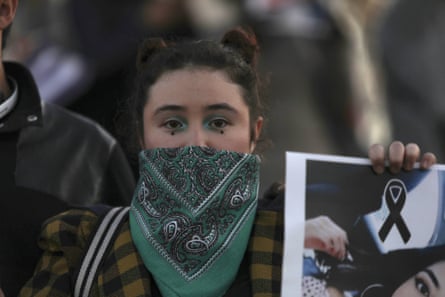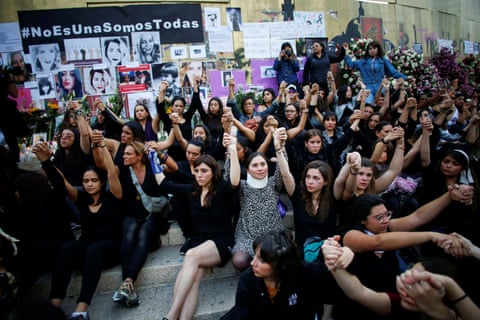Each day, María Salguero’s inbox floods with alerts telling the interminable tale of Mexico’s femicide crisis: “woman’s corpse”, “woman dismembered”, “woman stoned”, “woman stabbed”.
For the past four years the Mexico City activist has made a daily mission of documenting the death toll, and pinpointing each of the crimes and victims on an online map.

When Andrés Manuel López Obrador was elected in 2018, Salguero hoped Mexico’s supposedly progressive new president would take decisive action to slow a wave of killing that last year claimed the lives of 3,825 women.
Instead, Salguero’s research tells her things are getting worse: 10 or 11 women are now being killed each day, compared to six when she launched her map in 2016.

And – like many Mexican feminists – she voices frustration at the politician popularly known as Amlo.
“I feel betrayed, because I was one of those who voted for him,” said Salguero, 40. “We trusted that things could be different – but now we are seeing that this is just more of the same.”
Salguero is not alone.
After a politically explosive start to 2020, in which two horrific femicides sparked street protests and catapulted gender violence to the top of Mexico’s political agenda, many former Amlo supporters are expressing disenchantment.
Masked feminists daubed their discontent on to the presidential palace last month with slogans such as “Amlo is killing us” and “Let’s abort Amlo”.
“We all believed that with him things would be different. I thought this too,” said Frida Guerrera, a journalist and activist who recently confronted Mexico’s president at his morning press conference.
Microphone in hand, Guerrera implored Amlo to do more to fight Mexico’s “femicide emergency”.
“Femicide exists. We should never, ever deny that,” she said, demanding to know why Mexico lacked a special prosecutor’s office to deal with such crimes. “I’m sorry to raise my voice. [But] what is the president’s stance towards us women?”
Guerrera – who tells the stories of femicide victims on her blog - insisted she had not intended to pick a fight with Amlo.
“I’m not Andrés Manuel’s enemy,” she said. “I went because I don’t want to write any more stories - and because I truly believe we must treat this as a national emergency – and they do not want to accept this.”
But Amlo’s reaction did nothing to reassure Guerrera, or other women’s rights activists who believe the president’s response to the crisis has been haughty and evasive.

Amlo has enraged feminist activists by insinuating a nationwide women’s strike on 9 March was part of a conservative plot against his government and announcing he would inaugurate a populist raffle for his presidential plane on the very same day. (On Wednesady he announced he would postpone the launch, saying he “didn’t even realize” that the strike was planned for Monday.)
In another particularly notorious declaration, he attributed femicide to the “neoliberal policies” of previous administrations.
Political scientist Viridiana Ríos said she thought criticism of Amlo’s linking of neoliberal policies with femicide was mistaken.
“I think he is right. I personally [do] want to talk about the social problems that the economic model is creating because I believe that only if we do that are we going to find the right solutions,” said Ríos, who is part of a collective of young leftist thinkers called Democracia Deliberada.
But Ríos believed Amlo’s handling of the crisis had been damaging and counterproductive and stemmed partly from a conviction that the feminist movement was a political threat.

“He is now really empowering the opposition, and more critically he is perceived as insensitive,” Ríos said. “What could be worse for a leftwing politician than to be perceived as socially insensitive?”
As the killing continues, activists such as Salguero and Guerrera busy themselves fighting to give femicide victims a voice.
Each weekday, Salguero spends up to four hours up tapping details of the latest murders into her laptop. So far this year she has logged 320 deaths. Since launching her map in January 2016 there have been more than 9,000
At the weekend, Salguero tries to forget: going bike riding, posting photos of cats and dogs on Facebook or listening to Norwegian black metal to relax.
“This is how I get rid of all the stress of all this violence. Otherwise I would go mad,” she said.
At first Salguero recorded only basic details of each murder but increasingly she tries to add “context” – the key, she thinks, to finding policy solutions that can stop the slaughter.
How was the woman killed? Why? Was she pregnant? Was she alone? Was she raped? Was she thrown from a vehicle or dumped on a wasteland? Was the victim found clothed or naked? What kind of gun was used? How many knife wounds did she suffer?
“Sometimes you see victims who have been stabbed more than 100 times,” Salguero said. “Just imagine that level of viciousness. It just show you how much rage these men feel towards women.”
This year, as the femicide crisis has turned into a major political row, she and Guerrera have been targeted on social media. Salguero said some of the most venomous attacks came after she published the tally of women killed since Amlo took office in December 2018: 3,835.
“They went for my jugular,” Salguero said.
But she shrugged off such attacks and vowed not to abandon her map.
“If the president plays down the problem then what can you expect from the rest of society? I feel that if I don’t do something then it could be my nieces next. It could happen to any one of the women around me.”

